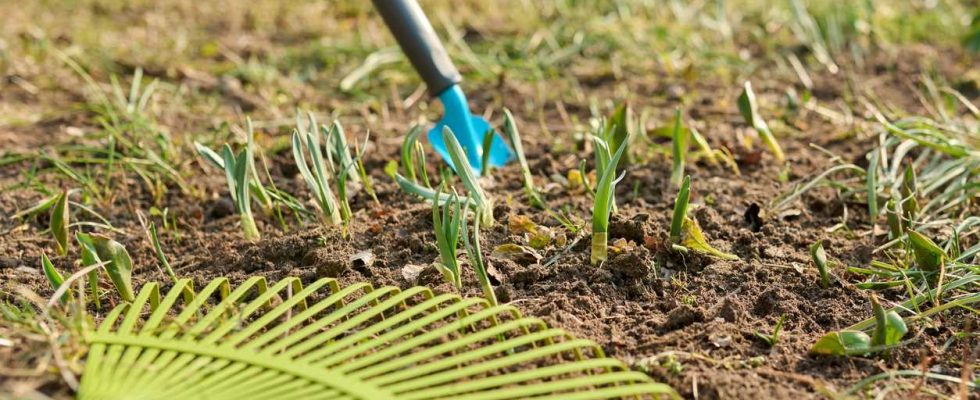
Work to be done in the vegetable garden
The work that you can carry out in your vegetable garden in February is essentially work aimed at anticipating the moment when it will be time to cultivate it:
- You can then start to aerate the soil. To do this, it is preferable to use a grelinette which will allow you to simply aerate the soil without turning it over. You will thus avoid disturbing the underground life which is so precious.
- You can start to prepare your different plots.
- You can add basic fertilizer to the vegetable garden. It is possible to incorporate manure or compost on the surface.
- You can spend some time check that the protections are in place on winter vegetables.
- When the weather is mild, you can remove the artichokes from their straw coveringbut be sure to put it back in place when there is a risk of freezing.
- Clean the strawberries by removing weeds and dead leaves. You can also add fertilizer.
- Continue to mulch the soil to protect plants from bad weather and prevent the soil from being left bare.
- To prevent condensation from causing disease in your greenhouse, consider ventilating it as often as you can.
Work to be done in the garden
In your garden, the time for large plantings has not yet come, but if the weather is on your side, you can still carry out a few maintenance tasks mainly:
- Like in the vegetable garden, make sure to keep the soil mulched to protect plants from bad weather and prevent the soil from being left bare. This mulch will also allow you to fight against the development of weeds.
- To keep your garden looking beautiful, maintain your lawn. This involves removing dead leaves accumulated on the lawn. In the same way, eliminate any moss that may have developed. To do this, you can use a scarifier on your lawn. These few steps will prevent your lawn from being suffocated. This is the right time if you want to add fertilizer.
- If you haven’t done so yet, you can plant biennials, as well as divide and replant your perennials. It’s time to plant rhododendrons and azaleas.
- Clean your hydrangeas by cutting dry branches.
- If you have hardy fuchsias in your garden, prune them to 10 cm from the ground. They will leave even more vigorous and will offer you more abundant flowering on sunny days.
- Take advantage of days when the soil is loose to weedthe work will be greatly facilitated.
Work to be carried out in the orchard
In the orchard too, it is possible to carry out a few tasks:
- Check whether your espaliers have withstood bad weather and, if necessary, repair them.
- Now is the time to take cuttings from your fig tree.
- If this is not done, finish pruning apple and pear trees.
- Prune your peach and raspberry bushes.
- Before the leaves come out and if there is no frost, consider pruning your vine. Remember that only the shoots of the year bear fruit.
- This is also a good time to graft apple trees.
Sowing to do in February
There are still few seedlings in February, but you can use this month to take stock of the seeds you have and those you will miss. This allows you to order them in advance and not miss anything when the time comes.
On the other hand, you can also take the opportunity to disinfect seedling boxes and buckets. This will prevent the spread of diseases.
You can slowly start to sow vegetables that need a little more time to get started in the heat:
- the eggplants ;
- peppers ;
- chili peppers;
- tomatoes.
Under cover, you can sow artichokes, celery, radishes, carrots, spring cabbage, lettuce, parsley, summer leeks.
If the soil is not too waterlogged, it is also possible to sow in open ground, in a well exposed location, beans, peas, onions and spinach.
Plantings for the month of February
You can start some plantings, provided the ground is not frozen. Here is what you can plant, knowing that this list is not exhaustive and that possible plantings are closely linked to the weather and climate of the region in which you live:
- Bulbils of onions, garlic and shallots;
- Rhubarb: if you already have rhubarb plants, now is the time to divide them;
- In mild climates, so-called early potatoes;
- Strawberries;
- Small fruit shrubs or bare root fruit trees;
- Hedges of evergreen shrubs;
- You can start planting summer bulbs in pots or in the ground. This is the case for lilies, gladioli, etc.
- Tarragon: this will allow this aromatic plant which does not fear the cold to take root deeper in the soil before summer. It will thus be better resistant to drought.
Harvests to be harvested in February
In February, you can harvest leeks, cabbages, spinach, cutting lettuce, lamb’s lettuce and parsnips. You can also pull out horseradish roots.
Pruning to do in February
Although several types of plants can be pruned in February, it is often better to wait until the frosts end. But again everything is linked to the weather and climate in your region. Here are the sizes you can make:
- The end of February is generally suitable for pruning rose bushes, making sure to eliminate all suckers and suckers.
- Tree sideyou can prune hazel, fig and quince trees.
- Side of small fruit shrubsyou can prune raspberries and gooseberries.
- You can also prune shrubs and vines that flower on year-old wood.. We will thus prune the winter jasmines and mimosas.
- If a shrub is poorly placed, you can move it.

